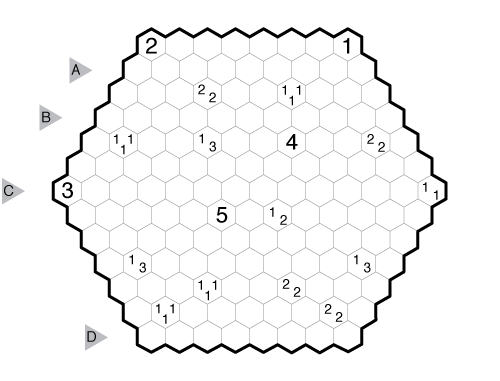Tapa (Hex) by Prasanna Seshadri

or solve online (using our beta test of Penpa-Edit tools; use tab to shift between shading mode and the composite Yajilin mode where left click marks cells, right click marks dots in cells or X’s on edges, left click+drag draws lines.)
Theme: Clue Symmetry and Logic
Author/Opus: This is the 66th puzzle from our contributing puzzlemaster Prasanna Seshadri.
Rules: Variation of Tapa. Instead of the normal 2×2 rule, on this hex grid no three cells in the connected Tapa can share a common vertex. All other rules apply.

Answer String: Enter the length in cells of each of the shaded segments from left to right for the marked rows, starting at the top. Separate each row’s entry from the next with a comma.
Time Standards (highlight to view): Grandmaster = 2:40, Master = 4:00, Expert = 8:00
Solution: PDF
Note: Follow this link for other Tapa variations and this link for classic Tapa. If you are new to this puzzle type, here are our easiest Tapa puzzles to get started on.

Loved the flow of this one.
When you say no entries repeat digits do you mean only the entries related to eacxh number or does this go for any set of adjacent hexes (the bottom row across, for example?)
I feel this isn’t for the Tapa but for the Hex Kakuro? If so, yes, any line of adjacent hexes must avoid repeated digits. If its for the Tapa, I’m sorry I can’t understand it, can you be clearer?
Sorry yes that was for the kakuro. I am on my phone and obviously hit the wrong comments button. If Thomas can relocate the comment I would be grateful Thanks for confirming that’s what I wanted to be sure I was inferring correctly.
9:20 I’m really enjoying relearning familiar puzzle types on hexagonal grids this week. Tapa feels very natural in this format, and this particular puzzle was very enjoyable.
Most square-grid puzzles use 4-way connectivity, so moving to a hexagonal grid increases options and flexibility. But Tapa is a puzzle that uses 8 neighboring cells on a square grid. So the hexagonal version has fewer possibilities. I would be curious to know if designers find it more constraining with the fewer available clue values.
I think this hex tapa solution are more aesthetically pleasing than most regular tapas… not that that means much, but I would like to see more of these in the future.
– Neelix
11:35
02:36. I wasted about 20-30 seconds not seeing a near-triangle.
Interesting variation, of course, with a smooth puzzle.
I wonder if Hex Tapa is done where only a 4-hex diamond is disallowed (a triangle is allowed)…